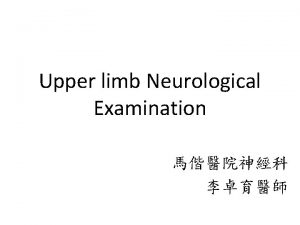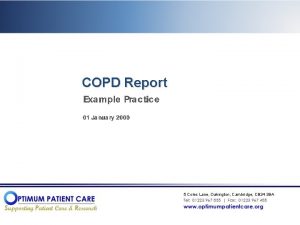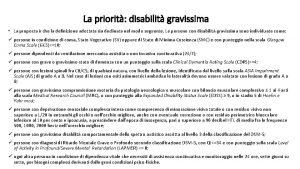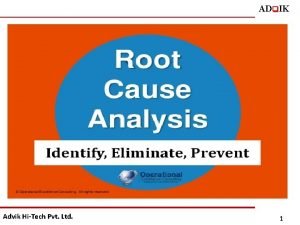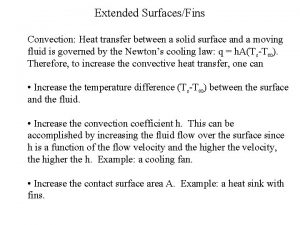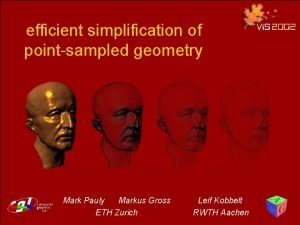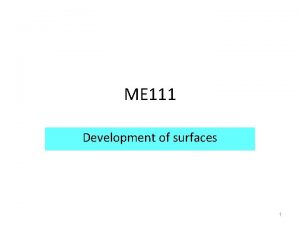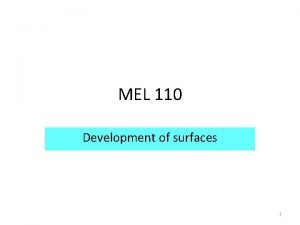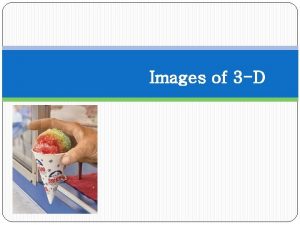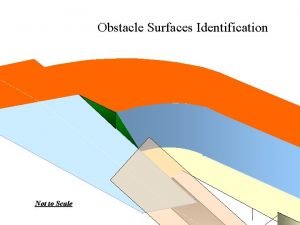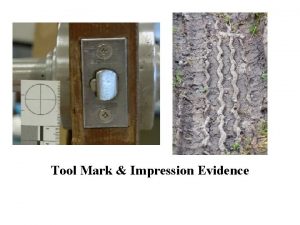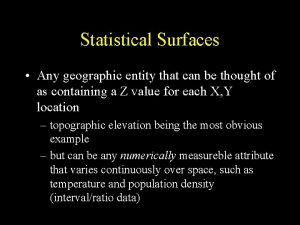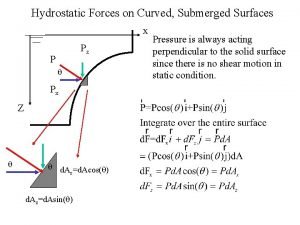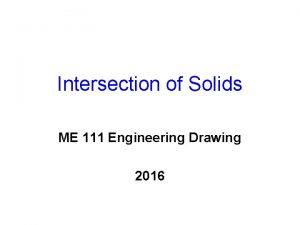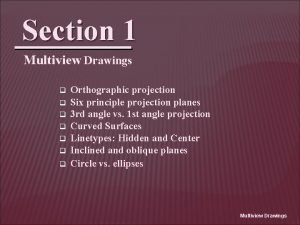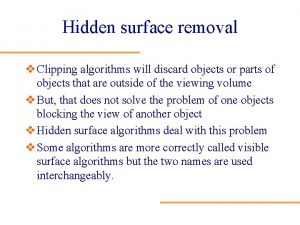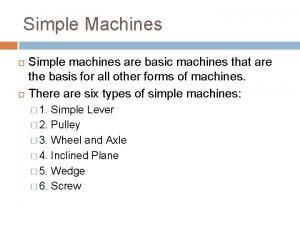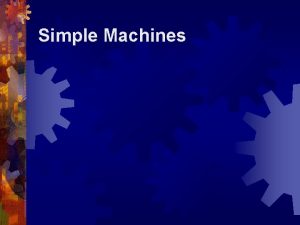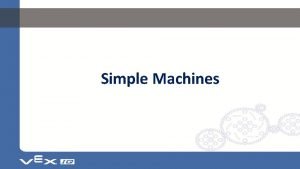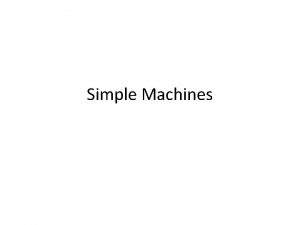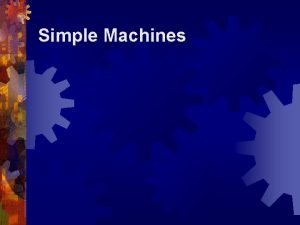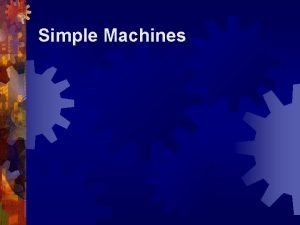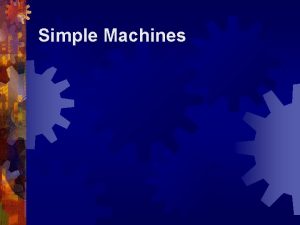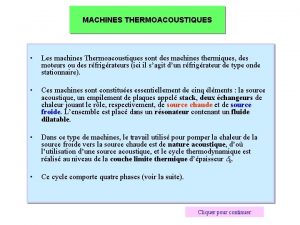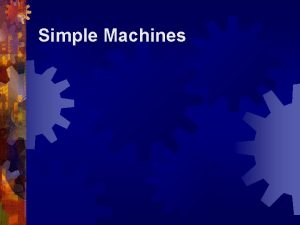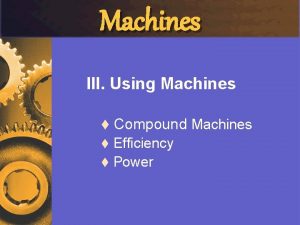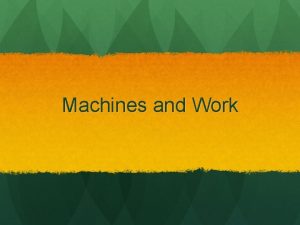Linear machines mrc 9 1 Decison surfaces We























































- Slides: 55

Linear machines márc. 9.

1 Decison surfaces • We focus now on the decision surfaces • Linear machines = linear decision surface • Non-optimal solution but tractable model

Decision surface for Bayes classifier with Normal densites ( i = esete)

Decision tree and decision regions

Linear discriminant function two category classifier: choose 1 if g(x) > 0 else choose 2 if g(x) < 0 If g(x) = 0 the decision is undefined. g(x)=0 defines the decision surface Linear machine = linear discriminant function: g(x) = wtx + w 0 w weight vector w 0 constant bias 4

5

More than 2 categories c linear discriminant function: i is predicted if gi(x) > gj(x) j i; i. e. pairwise decision surfaces defines the decision regions 6

7

Expression power of linear machines It is proved that linear machines can only define convex regions, i. e. concave regions cannot be learnt. Moreover the decision boundaries can be higher order surfaces (like elliptoids)… 8

Homogen coordinates

10 Training linear machines

Lineáris gépek tanulása • Searching for the values of w which separates classes • Usually a goodness function is utilised as objective function, e. g. 11

Two categories - normalisation if yi belongs to ω2 replace yi by -yi then search for a which atyi>0 (normalised version) There isn’t any unique solution. 12

Iterative optimalisation • The solution minimalises J(a) • Iterative improvement of J(a) a(k+1) a(k) Step direction Learning rate 13

14 Gradient descent Learning rate is a function of k, i. e. it describes a cooling strategy

Gradient descent 15

Learning rate? 16

Perceptron rule

Perceptron szabály Y(a): the set of training samples misclassified by a If Y(a) is empty Jp(a)=0; else Jp(a)>0

Perceptron rule – Using Jp(a) in the gradient descent: 19

20 Misclassified training samples by a(k) Perceptron convergence theorem: If the training dataset is linearly separable the batch perceptron algorithm finds a solution in finete steps.

21 η(k)=1 online learning Stochastic gradient desent: Estimate the gradient based on a few trainging examples

Online vs offline learning Online learning algorithms: The modell is updated by each training instance (or by a small batch) Offline learning algorithms: The training dataset is processed as a whole Advantages of online learning: - Update is straightforward - The training dataset can be streamed - Implicit adaptation Disadvantages of online learning: - Its accuracy migth be lower

23 Not linearly separable case – Change the loss function, it should count each training example e. g. the directed distance from the decision surface

SVM

25 Which one to prefer?

26 • Margin: the gap around the decision surface. It is defined by the training instances closest to the decision survey (support vectors)

27

Support Vector Machine (SVM) 28 • SVM is a linear machine where the objective function incorporates the maximalisation of the margin! • This provides generalisation ability •

SVM Linearly separable case

Linear SVM: linearly separable case • Training database: • Searching for w s. t. or 30

Linear SVM: linearly separable case • Note the size of the margin by ρ • Linearly separable: • We prefer a unique solution: • argmax ρ = argmin 31

Linear SVM: linearly separable case 32 Convex quadratic optimisation problem…

Linear SVM: linearly separable case The form of the solution: Weighted avearge of training instances bármely t-ből xt támasztóvektor iff only support vectors count 33


SVM not linearly separable case

• ξ slack variable enables incorrect classifications („soft margin”): ξt=0 if the classification is correct, else it is the distance from the margin C is a metaparameter for the trade-off between the margin size and incorrect classifications Linear SVM: not linearly separable case 36


SVM non-linear case

Generalised linear discriminant functions • E. g. quadratic decision surface: • Generalised linear discriminant functions: yi: Rd → R arbitrary functions g(x) is not linear in x, but is is linear in yi (it is a hyperplane in the y-space)

Example



Non-linear SVM 43

Non-linear SVM Φ is a mapping into a higher dimensional (k) space: There exists a mapping into a higher dimensional space for any dataset where the dataset will be linearly separable in the new space. 44

The kernel trick g(x)= The calculation of mappings into high dimensional space can be omited if the kernel of to x can be computed 45

46 Example: polinomial kernel K(x, y)=(x y) p d=256 (original dimensions) p=4 h=183 181 376 (high dimensional space) on the other hand K(x, y) is known and feasible to calculate while the inner product in high dimensions is not

47 Kernels in practice • No rule of thumbs for selecting the appropiate kernel

48 The XOR example

49 The XOR example

50 The XOR example

51 The XOR example

52 Notes on SVM • Training is a global optimalisation problem (exact optimalisation). • The performance of SVM is highly dependent on the choice of the kernel and its parameters • Finding the appropriate kernel for a particular task is „magic”

53 Notes on SVM • Complexity depends on the number of support vectors but not on the dimensionality of the feature space • In practice, it gaines good enogh generalisation ability even with a small training database

Summary • • Linear machines Gradient descent Perceptron SVM – Linearly separable case – Not separable case – Non-linear SVM
 Ndm model
Ndm model Hipersonorite
Hipersonorite Deepa tailor
Deepa tailor Escala mrc
Escala mrc Hipotalamo funcion
Hipotalamo funcion Mrc oulu
Mrc oulu Power lower limb
Power lower limb Chula mrc
Chula mrc Fairfax mrc
Fairfax mrc Mrc dyspnoea scale
Mrc dyspnoea scale Mrc escala
Mrc escala Mrc modificada
Mrc modificada Mrc skills development fellowship
Mrc skills development fellowship Mrc scale
Mrc scale Mrc dyspnoea scale
Mrc dyspnoea scale Index de bode bpco
Index de bode bpco Modified mrc scale
Modified mrc scale Mrc scala forza
Mrc scala forza Mrc clinical trials unit
Mrc clinical trials unit Trc mrc root cause
Trc mrc root cause Mrc grade
Mrc grade Can two equipotential surfaces intersect
Can two equipotential surfaces intersect Vertical
Vertical What are the three main types of body membranes
What are the three main types of body membranes Inclined surfaces in orthographic projections
Inclined surfaces in orthographic projections Advection vs convection
Advection vs convection Efficient simplification of point-sampled surfaces
Efficient simplification of point-sampled surfaces Parathyroid gland chief cell
Parathyroid gland chief cell Subdivision surfaces in character animation
Subdivision surfaces in character animation Development of surfaces
Development of surfaces What is development of surfaces
What is development of surfaces Development of surfaces pentagonal prism
Development of surfaces pentagonal prism Cylinder heat transfer
Cylinder heat transfer Three dimentional shapes
Three dimentional shapes Cgh begum
Cgh begum Obstacle identification surface
Obstacle identification surface Chapter 2 lesson 1 gravity and friction
Chapter 2 lesson 1 gravity and friction Aircraft control surfaces and components
Aircraft control surfaces and components Patent impressions
Patent impressions Magic wall interactive surfaces market segments
Magic wall interactive surfaces market segments Nationalism in india
Nationalism in india 7 faces 12 edges 7 vertices
7 faces 12 edges 7 vertices When a solid completely penetrates another solid
When a solid completely penetrates another solid To determine missing z values for a statistical surface
To determine missing z values for a statistical surface Hydrostatic forces on curved surfaces
Hydrostatic forces on curved surfaces Gj mount classification of dental caries
Gj mount classification of dental caries The relative lightness and darkness of surfaces.
The relative lightness and darkness of surfaces. Interpenetration of solids
Interpenetration of solids Ted bundy teeth
Ted bundy teeth Access cavity krasner and rankow
Access cavity krasner and rankow Walking on slippery surfaces
Walking on slippery surfaces Indentation mark definition forensics
Indentation mark definition forensics Walking and working surfaces quiz
Walking and working surfaces quiz Normal inclined and oblique surfaces
Normal inclined and oblique surfaces Hidden surface algorithm
Hidden surface algorithm The refractive indices of crown glass prism for c d f
The refractive indices of crown glass prism for c d f






